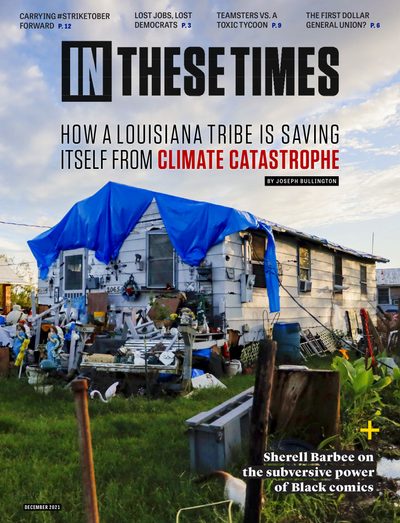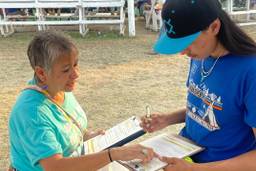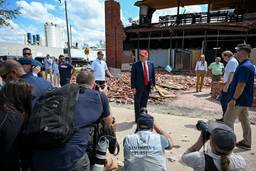After Ida, This Louisiana Tribe Is Organizing Its Own Recovery
Armed with agricultural knowledge and mutual aid networks, the Houma people aren’t waiting on the government to rescue them.
Joseph Bullington
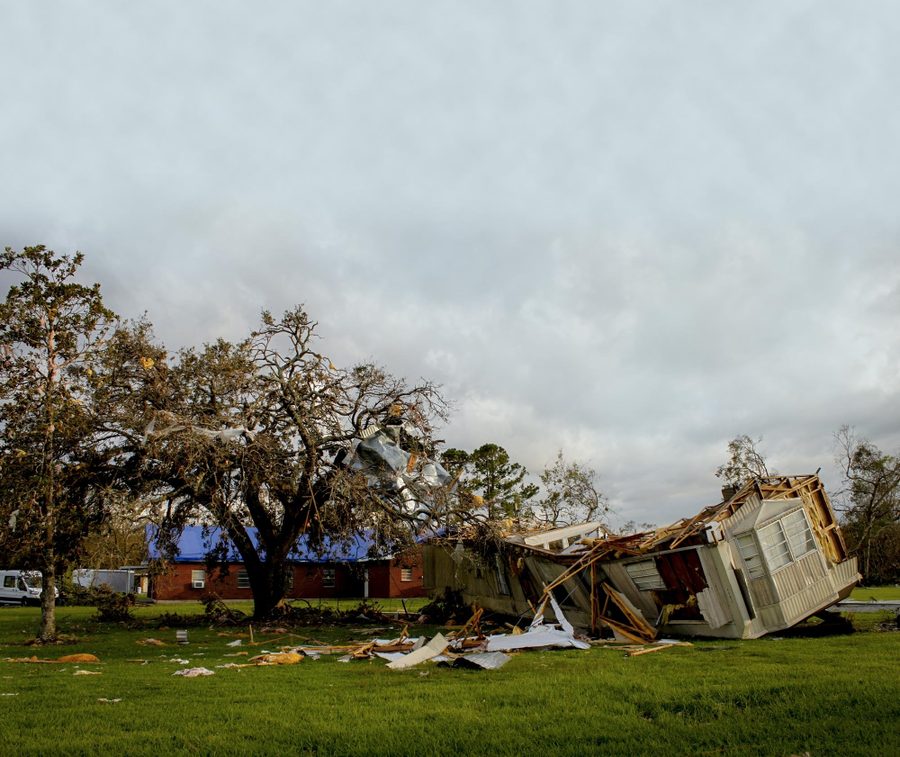
Three days after Hurricane Ida hit, I drove home to south Louisiana beneath a pall of oily smoke. Lacking power, Shell’s refinery in Norco was disposing of refining chemicals by flaring them off in huge black plumes.
The storm had knocked out electricity across the region. Gasoline, too, was scarce. Some gas stations had been ripped apart and most of the rest had no gas, so the few that did had half-mile-long lines, presided over by police cars with flashing lights.
Ida Aronson, a member of the United Houma Nation who lives in Lafourche Parish, can’t help but see the irony: Here, on a coast choking on refinery smoke and literally dying from the wounds inflicted by the oil industry, what little fuel people could get had to be delivered from afar in red plastic jugs.
It wasn’t only ironic; it was disturbing. It conjured up the same uneasy feeling as the food system failures at the beginning of the Covid-19 pandemic in 2020 — the terror of dependence on structures that, in the face of environmental upheavals, prove increasingly undependable.
In March 2020, Aronson began turning a 14-acre strip of tribe-owned land in Terrebonne Parish into the Yakani Ekelanna Community Garden and Food Forest, conceived as a step toward food autonomy and a place to reclaim traditional Houma knowledge and culture. Aronson began renovating an old house on the property, planted fruit trees and built garden beds.
After the hurricane, the garden took on a new role as a staging ground for the tribe’s disaster response to distribute supplies, coordinate mutual aid groups and help tribal members, who, along with other Native people in south Louisiana, were among the hardest hit. In the long run, Aronson hopes Yakani Ekelanna can combine these functions to become a sort of “laboratory”— a place for building tribal sovereignty and resilience against an uncertain future.
For hundreds of years, Aronson’s Houma ancestors may have followed a route similar to the one I took that day, southeast from their agricultural villages on the Red River to a Houma village site on Bayouk Choupic, a small waterway that runs within a half-mile of where I stay in present-day New Orleans (the word bayou comes from the Choctaw word bayouk). Here, the lower Mississippi River winds close to Lake Pontchartrain, a vast estuary where fresh water mixes with salt water from the Gulf of Mexico.
These earlier travelers would’ve known this area as Bulbancha, a Choctaw word that translates to “the place of many tongues.” According to Aronson and other members of the Bvlbancha Collective, this was a place where people from many different Indigenous nations met, traded, danced and kept ceremony, a sort of cosmopolitan Indigenous city that predates New Orleans.
One important difference, though, is that Bulbancha was
seasonal. The inhabitants changed how and where they lived in accord
with the waters that surround it, not the other way around. Like all of
southern Louisiana, the land was put here by the river, carried down as
sediment from across the continent and deposited during seasonal floods
across a wide alluvial plain, held together by the roots of plants. The
land is here because the river is here. Periodic flooding is part of the arrangement.
The result of this process is a sprawling, ragged-edged land of cypress swamps, marshes and estuaries rich with fish, crustaceans and other marine life. European colonial powers (and, later, the United States) mostly regarded these wetlands as wastelands. They are hard places to live year-round — hot, buggy, often flooded, vulnerable to storms.
That these lands were unattractive to Europeans, though, made them attractive to the Houma. As colonization advanced, Aronson explains, and as European powers pitted tribes against one another, the Houma were pushed southward from the Red River area and into these marshlands.
As Aronson puts it: “We escaped the Trail of Tears by moving further down into the swamps.”
This is how many Houma people came to live on the southern edge of Louisiana in Lafourche and Terrebonne parishes, directly in the path of Hurricane Ida, one of the largest hurricanes ever to make landfall in the United States.
“People do not tend to find themselves living in risky places because of cosmic bad luck,” writes historian Andy Horowitz in Katrina: A History, 1915-2015. “Structures of power push them there.”

Colonization changed not only where people lived on the Louisiana coast, but how they lived. In The Gulf: The Making of an American Sea, environmental historian Jack E. Davis describes how Indigenous cultures thrived on the staggering richness of the Gulf’s estuaries. In contrast, the first Europeans to reach the Gulf slogged through — often starving — in search of a different kind of riches.
“European conquest,” Davis writes, “introduced a future of imprudent relationships with nature in place of successful ones.”
The same alluvial process that built southern Louisiana buried millions of years’ worth of decaying sea-floor organic matter beneath a thick layer of sediment. Pressure and heat transformed that carbonous muck into oil — and lots of it.
Following the first successful well drilled in 1901, an oil rush swept the coast. By the end of the century, 181,000 oil and gas wells had been drilled in Louisiana. It would be hard to overstate the significance of this oil in the history of the state or the country. Horowitz puts it this way: “The American dream was fueled by oil, and a lot of it came from Louisiana.”
For this wealth, the coast has paid a terrible price.
When R. Eugene Turner took his first flight over the Louisiana coast in 1974, he looked down and saw the makings of a disaster. Spread out below was a colossal network of canals — straight, watery lines cut through the marsh.
“It just didn’t look right,” Turner tells me.
Something, indeed, wasn’t right. Louisiana’s coastal wetlands were disappearing into the Gulf of Mexico at an unignorable rate. Turner, now a professor in the Department of Oceanography and Coastal Sciences at Louisiana State University, has spent much of his career since that flight studying the causes, consequences and cures of this land loss.
Companies dredged these canals through the marsh to get to and from oil wells. By 2017, according to research Turner conducted with biologist Giovanna McClenachan, some 10,472 miles of oil and shipping canals cut through the marshes — enough to cross the Louisiana coast nearly 840 times. “Clearly,” Turner and McClenachan wrote in 2018, “this is a significant factor influencing wetland health.”
In addition to the wetlands directly destroyed by dredging, “spoil banks” of dredged-up muck along the canals disrupt wetland hydrology and eventually transform nearby marsh into open water. The canals also act as avenues for salt water to intrude upon freshwater parts of the marsh, killing the plants that hold the land together. Since 1932, the Louisiana coast has lost around 2,000 square miles of land. Though the rate of land loss has slowed, Louisiana continues to lose close to 17 square miles of wetlands every year.
Oil extraction isn’t the only cause of wetland loss. With the Mississippi River leveed in the name of flood control, the periodic floods that used to bolster this naturally sinking land with new layers of sediment rarely happen. But Turner estimates the oil and shipping industries have caused 90% of it. To Turner, one solution is clear: Backfill the old canals. It would be cheap, he says, compared with the more ambitious and expensive plans from the state and federal government to create sediment diversions on the river. Asked why his idea has been slow to gain traction, Turner responds this way: “It’s a tender subject, I guess. This is an oil and gas state.”
Now, sea level rise caused by climate change has joined canals and levees as an existential threat to the wetlands. “We’re approaching a tipping point where the plants won’t hold on,” Turner tells me.
What does that mean?
“It means the marshes are going to go away,” Turner explains, chuckling sadly.
The death of these rich estuaries would mean the collapse of a fishery that sustains thousands of commercial and subsistence fishers, many of them Indigenous. And land loss, many argue, also means increased vulnerability to hurricanes (although some scientists, including Turner, don’t think it’s a major factor).
“The hurricanes have gotten so much worse,” Ida Aronson says. Pockets of hot water in the Gulf, exacerbated by climate change, fuel bigger, more powerful hurricanes. And now, the logic goes, there’s less land to buffer cities and towns on the coast from these stronger storms.
“There used to be barrier islands,” Aronson says. “There used to be so much land to break the brunt of the storms. Now there’s nothing to slow these storms from hitting as hard as they can.”
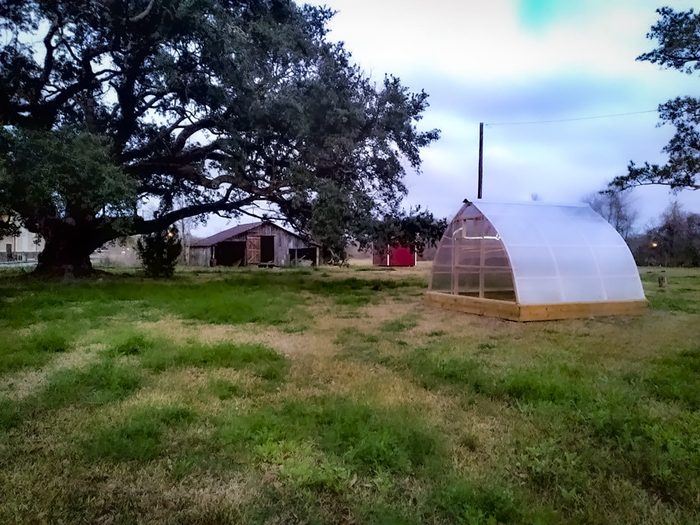
Eighteen days after the storm, a friend and I climb to the roof of a trailer house in Terrebonne Parish to secure a tarp over a gaping hole. We don’t have enough tarps to cover all the smaller holes that, judging by their rusty edges, predate the storm. After, we look around. Southern Louisiana’s deltaic flatness means you rarely get a view like this, from above.
Spread out in every direction is the wreckage of a trailer park where a hundred or more people lived, where many will no doubt find ways to keep living. Most of the trailers have tarps shielding broken roofs. Other trailers, beyond salvation, have been knocked off their foundations, their insides hanging out, their framing exposed like ribs. One singlewide lies upside down, its wheels in the air.
Maybe the best way to get a sense of the scale of the destruction is not to tally statistics, but to attempt to clean it up. After a day baking on an asphalt roof or sawing and hauling a pecan tree that crushed a shed, you look at the debris piles differently. You see them as hot work that has to be done, much of it by hand, and you feel what a daunting mess the people who live here face.
I’m here as part of a mutual aid crew to help with the United Houma Nation’s self-organized disaster response. The Houma elder who lives in the house we’re standing on isn’t home — they’ve evacuated somewhere. The electricity is still out and the house is barely livable.
Some tribal members, Aronson tells me, have nowhere to go and no choice but to keep living in storm-damaged houses, where rain leaks in and mold flourishes in the perpetual dampness. One Houma woman I spoke with said she didn’t have electricity, but didn’t need gasoline for her generator regardless. She lives alone and doesn’t have the strength to pull the thing out of the shed and start it, let alone repair the damage to her house.
This is the tribe’s twofold task: First, to try to make sure their people, particularly elders, have a safe place to live and access to water, food, gas and other essentials. Second, to make sure the people who are still gone — the people who make up what Aronson calls the “forced diaspora”— have something to come back to, to make sure the evacuations don’t become permanent.
Aronson phrases the challenge this way: “How do we help our people stay in place? How do we help our people hold on to their sense of identity and their lands?”
The tribe’s physical and cultural survival is at stake, according to Jordan Menard. “Making sure the elders are safe — that’s all I care about,” Menard says good-naturedly between bouts with his constantly buzzing phone.
Coordinating this response is a colossal job, and Menard shoulders a large share of it from his base at Yakani Ekelanna. Though the state of Louisiana officially recognizes the United Houma Nation, the tribe has never been granted federal recognition and has no federally guaranteed reservation land. The tribe’s 17,000 members live scattered across the tribe’s six-parish, 4,500-square-mile service area and beyond, though most live in Terrebonne and Lafourche.
A day in Menard’s life right now might involve a stop in Houma at the tribal center (now in the process of being gutted), then a drive south to tarp a roof on Shrimpers Row in Dulac, then down to the end of the line in Cocodrie to drop off supplies, then up to Montegut to deliver a can of gas, then home to Yakani Ekelanna, completing an 80-mile (and many hour) circuit. The hurricane damaged homes in all six parishes, Aronson says, and hammered some of the tribal leaders who would normally be coordinating the response.
“Half of our staff and half of our council are homeless,” Aronson says. “They have to worry about their own homes.”
On top of that, the tribe’s lack of federal recognition precludes some federal aid money and relief programs, according to Adam Crepelle, an assistant law professor at George Mason University and a United Houma Nation citizen, who talked with the Times-Picayune/New Orleans Advocate. Because unrecognized tribes are treated as nonprofits, each member must apply for federal aid individually.
Some needs, however, can’t wait — like water for a homebound elder, or tarps for a roof to prevent permanent damage. And around here, federal aid is notorious for being slow.
Federal Emergency Management Agency Administrator Deanne Criswell praised her agency’s response at a September 3 press conference during President Joe Biden’s post-storm visit to Louisiana. “We’ve also turned on the Blue Roof program,” Criswell said, referring to a mission managed for FEMA by the U.S. Army Corps of Engineers to install temporary roofs in disaster areas. “We saw some of the blue roofs as we flew in today.”
Cedric Richmond, a senior Biden advisor and former Louisiana congressman, was sitting next to Criswell at the press conference. Richmond responded with the words many Louisianans were already shouting at their battery-powered radios: “A lot of those roofs are up because the people of Louisiana decided to get on their roof, put up a tarp.”
Though the federal government supplied some tarps, five more days would pass before the first official blue roof was installed September 8.
Aronson and Menard were among those not waiting for help.
“We know the state and parish always fail us,” Aronson says. “Our community down here already knows it’s the community that’s got us.”
Shortly after the storm, the two converted Yakani Ekelanna into a hub for the tribe’s disaster response. They used the barn to store tarps, roofing nails and chainsaws. Beneath a live oak, they set up tents to house mutual aid crews from New Orleans and elsewhere. They built a “United Houma Nation Elder Needs” spreadsheet with entries like “tarping needed, food water gas delivery” and “have tarp, just need help,” and began working through it. They delivered gas, water, food and building supplies to elders and others with limited mobility, and set up two free markets in the area.
Disaster recovery and farming may seem like unrelated projects, but Aronson doesn’t see it that way. In Aronson’s mind, recovery means more than storm cleanup because the disaster — like most of the holes in that trailer roof, like the holes in the coast — predates the storm.
“What I hope my namesake hurricane has brought about is a real conversation about how this system is simply unsustainable,” Aronson says. “Let’s build new systems so they can’t fail us again, so we have our own back.”

That’s a tall order and Aronson knows it, but that was the idea behind Yakani Ekelanna in the first place — to build Houma food sovereignty as the pandemic revealed the weaknesses of the industrial food system. Aronson planted the beginnings of a food forest (with citrus trees, American persimmons, mayhaw, blueberry bushes, mulberries and wild cherries, with plans for nut trees), built a greenhouse (in partnership with the Land Memory Bank & Seed Exchange and WECAN International) and planted the first beds for a community garden, where Houma citizens will be able raise a plot of food.
Traditionally, Aronson says, Houma people tended food gardens and foraged (and maintained) wild plants to supplement the fish and shrimp from the estuaries. Now, “because of the way capitalism is, there just isn’t time for [gardening].” Yakani Ekelanna plans to remedy the issue by helping people tend their plots when they’re not able to be there. Only about two acres of the farmland are under cultivation now, which leaves about 11 acres for expansion.
Another component of the sovereignty Aronson envisions is breaking dependence on the fossil fuel industry that has been so detrimental to this coast. Yakani Ekelanna recently acquired several portable solar generator setups that include panels and batteries, with plans to install a larger system soon. There are plans to equip a remodeled Houma tribal center with a new solar backup system. And, in the wake of the storm, Aronson says, many tribal citizens have expressed interest in solar but lack resources and know-how. Aronson hopes Yakani Ekelanna can become a place to distribute knowledge about solar equipment to people throughout the United Houma Nation.
Aronson also sees a role for the farm that’s harder to define. One of Aronson’s friends calls the place a “climate experimentation laboratory.” To Aronson, this means saving seeds and keeping a seed bank of plants adapted to the new climate. It also means sustaining mutual aid networks that can hold the community together through upheavals. It means repairing the relationship with the non-human world.
“This concept of mutual aid is not just between humans,” Aronson says. “If we protect the land and waters, they will protect us.”
Ultimately, it means relearning old ways and forging new ways to live on this rich, fraught, vanishing coast, in order to weather the storms to come.
Joseph Bullington grew up in the Smith River watershed near White Sulphur Springs, Montana. He is the editor of Rural America In These Times.
